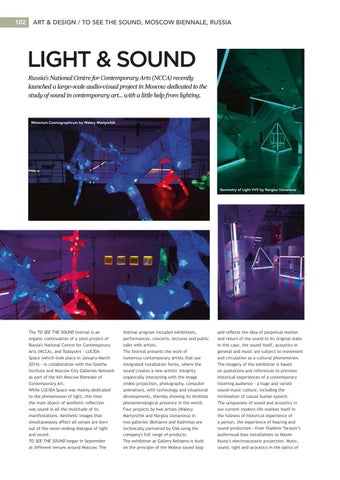102
ART & DESIGN / TO SEE THE SOUND, MOSCOW BIENNALE, RUSSIA
LIGHT & SOUND Russia's National Centre for Contemporary Arts (NCCA) recently launched a large-scale audio-visual project in Moscow dedicated to the study of sound in contemporary art... with a little help from lighting.
Misterium Cosmographicum by Walery Martynchik
Geometry of Light VVV by Nargiza Usmanova
The TO SEE THE SOUND festival is an organic continuation of a joint project of Russia's National Centre for Contemporary Arts (NCCA), and TodaysArt - LUCIDA Space (which took place in January-March 2014) - in collaboration with the Goethe Institute and Moscow City Galleries Network as part of the 6th Moscow Biennale of Contemporary Art. While LUCIDA Space was mainly dedicated to the phenomenon of light, this time the main object of aesthetic reflection was sound in all the multitude of its manifestations. Aesthetic images that simultaneously affect all senses are born out of the never-ending dialogue of light and sound. TO SEE THE SOUND began in September at different venues around Moscow. The
festival program included exhibitions, performances, concerts, lectures and public talks with artists. The festival presents the work of numerous contemporary artists that use integrated installation forms, where the sound creates a new artistic integrity organically interacting with the image (video projection, photography, computer animation), with technology and situational developments, thereby showing its limitless phenomenological presence in the world. Four projects by two artists (Walery Martynchik and Nargiza Usmanova) in two galleries (Beliaevo and Kashirka) are technically partnered by GVA using the company's full range of products. The exhibition at Gallery Beliaevo is built on the principle of the Mobius sound loop
and reflects the idea of perpetual motion and return of the sound to its original state. In this case, the sound itself, acoustics in general and music are subject to movement and circulation as a cultural phenomenon. The imagery of the exhibition is based on quotations and references to previous historical experiences of a contemporary listening audience - a huge and varied sound-music culture, including the minimalism of casual human speech. The uniqueness of sound and acoustics in our current modern life realises itself in the fullness of historical experience of a person, the experience of hearing and sound production - from Vladimir Tarasov’s audiovisual bass installations to Maxim Ksuta’s electroacoustic projection. Music, sound, light and acoustics in the optics of
